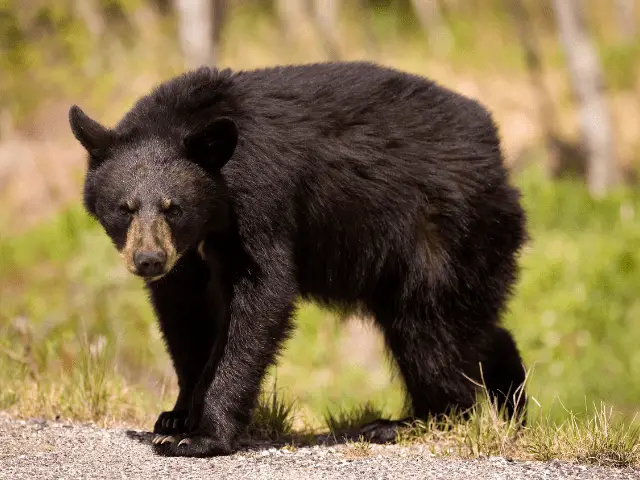Hiking with your dog can be an incredible experience, but it’s important to take the proper precautions in bear country. This article will give you some tips on what to do if you encounter a bear while hiking with your dog, and how to stay safe while hiking with your dog in bear country.
Keep reading to learn more!
This article contains affiliate links. If you purchase through one, I may receive a commission.
Know What Time of Year Bears are Most Active

The best way to stay safe while hiking in bear country to simply avoid bears as much as possible. The best way to do this is by being very conscious of when you decide to hike.
Hiking during certain times of the year is more dangerous than others. Hikes through forested areas should be avoided when black bears are most active:
- Late summer, when they’re looking for food to gain weight before winter hibernation
- Early spring, as they prepare to come out of hibernation.
Stay close to your dog and let it do most of your smelling for you, they may be able to alert you to the bear before you can see it.
In some areas, you may want to avoid hiking near streams and lakes entirely. Just other predators such as bobcats and cayotes, bears tend to seek out watering holes at dusk or dawn.
If possible, postpone your hike until after the morning or before dusk when you’re less likely to come across a bear’s location if the hike is near water.
Whether or not you see any signs of bear activity on your trip is irrelevant—if they’re present in an area, it’s worth thinking twice about hiking there while they are active.
At all times on your hike, remember that sudden movements can trigger a bear attack.
Keep Your Dog on a Short Leash
If you’re hiking a trail that might lead you past bears, keep your dog on a short leash. A lunging, barking dog will make it clear to bears that you are coming their way.
Ideally, bring two leashes so one can be wrapped around your waist or bag and have only about 3 feet of leeway for your pup. That way, if he or she does spot a bear, you can quickly reel them back in without putting yourself at risk of injury from an aggressive pooch.
If hiking with more than one dog, consider bringing one leash per canine companion instead of a split leash to ensure they don’t become tangled up when chasing wild animals—or each other!
Although your dog’s nose might be highly sensitive to smells, bears also have a highly developed sense of smell and are very capable of sniffing out food and other small animals. Also keep an eye on any curious dogs at the trailhead—an off leash dog may provoke nearby wildlife before the owners can recall them.
The best-case scenario is that you spot a bear before it sees you and your dog. In those cases, stay calm, keep your eye on your dog, and calmly alert the bear of your presence while keeping your dog’s focus on you.
Store Food Properly
Do everything you can to store your food and other smelly items (such as trash) in sealed containers and/or car trunks. A bear will travel miles for a meal, so if it picks up on a scent from a mile away, chances are it’s going to check out that source of food.
It’s best to avoid carrying smelly items while hiking with dogs, especially in areas known for bears. If you must take those items with you, put them into hard-sided containers or bury them deep into your backpack or daypack so they don’t spill or leak their contents.
Keeping food odor to a minimum while hiking is especially important if you plan on camping. Tents and other shelters are still susceptible to intruders, even though there’s no actual food inside them.
Overnight campers should store their food in specially designed containers (Bear Canisters ) —which have their own lids for added security—and double-bag their trash (all of it, not just food scraps) so bears will have a harder time smelling what’s inside.
) —which have their own lids for added security—and double-bag their trash (all of it, not just food scraps) so bears will have a harder time smelling what’s inside.
If you’re backpacking, pick a designated site away from water sources where you can hang your food and garbage securely between two trees using rope or straps. Allowing a bear access to your smelly goodies is an invitation for trouble!
Bears aren’t likely to attack humans unless they feel threatened, so if you take care to be as inconspicuous as possible while hiking and camping with dogs in bear country, you’ll greatly reduce your chances of encountering a hungry bear.
Don’t Approach Wildlife
The best way to handle wildlife while hiking with your dog is to not approach it. Stay calm and avoid eye contact with a wild animal as much as possible. If you encounter an animal (e.g., a snake, moose, bear) away from your house or trailhead, don’t run away.
Speak in low tones to reassure the animal that you don’t look like food. Better yet, have your dog sit beside you so he doesn’t look appetizing either!
You want to make yourself appear bigger than you are—so your dog goes along with you too! Bears are naturally frightened by larger animals. So if yours thinks you look scary, then he’ll make sure his fear is obvious so that no one messes with him!
When you’re hiking with your dog, it’s also important to have bear spray on hand as a last resort. If the worst happens and the bear begins to charge you and your dog, you can use the bear spray to scare it off.
on hand as a last resort. If the worst happens and the bear begins to charge you and your dog, you can use the bear spray to scare it off.
Understand the Different Bears You Could Encounter

The two types of bears you’ll find in North America are black bears and brown/grizzly bears.
Most of the things to do to avoid a bear encounter is the same for both types of bears, however, if you come in contact with a bear, the steps to keep you and your companions safe is different depending on the type of bear you encounter.
If you are hiking on the Western side of North America, chances are you’ll encounter a grizzly bear. These big bears live mostly in national parks and remote wilderness areas. Though rare, black bears and grizzlies can sometimes overlap.
But chances are when you’re hiking, you’ll see either a black or brown bear—black bears occupy most of America except for Alaska and Canada.
Brown bears on average weigh about 400 pounds more than their smaller cousins so it’s important to know how to distinguish them if you’re hiking with dogs in bear country.
Like black bears, brown bears tend to avoid humans but have been known to attack people—especially if they are surprised or feel threatened.
If you do come across a brown bear while hiking, your first step should be to assess its behavior. If it’s not showing signs of stress or aggression (ears flat, alert, moving toward you) you should play dead.
Lay flat and use your hands to cover the back of your neck. If your dog is small, you may consider carefully laying over them to keep them from the bear’s sight as long as they can stay quiet.
Black bears are more common than brown bears and less aggressive. You may only see one if you visit national parks like Yosemite but chances are good that you won’t run into any kind of bear at all on your hike.
If you do encounter a black bear, it’s likely to stay at a distance and observe your behavior rather than be aggressive.
However, if you surprise it or come between a mother and her cubs, it may charge at you out of fear—while black bears rarely attack humans, they can be very dangerous.
Black bears are less aggressive than brown bears but should still not be approached. If one does see or hear you coming—especially if there are cubs around—it’ll either try to run away or go on high alert to see what it should do next.
The National Park Service has additional tips on staying safe while hiking in bear country that can help you prepare. What tips do you have about staying safe in bear country? What would you add to our list?
that can help you prepare. What tips do you have about staying safe in bear country? What would you add to our list?
